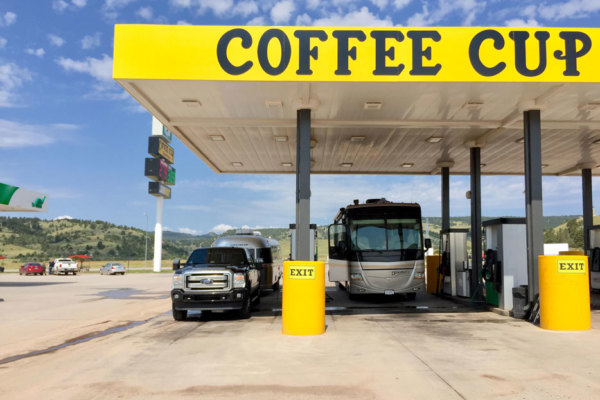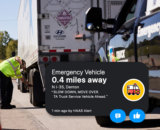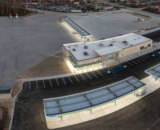A member recently asked me how she could drive more RV traffic to her travel center. RVs are a growing market and an often untapped customer base for travel plaza operators.
Whether we’re talking about those who take out their motorhomes and travel trailers on the weekends, the surprising number who use them to live on the road seasonally or full-time, these customers seek many of the same amenities you’re already offering to professional over-the-road drivers. If RVers aren’t on your radar, they should be.
I recently sat down with a friend who has spent the better part of four years and accumulated more than 100,000 miles traveling the country in a diesel-powered pickup towing a 30-foot travel trailer to learn more about his life on the road. He shared his experiences and made some recommendations for how truckstops and travel plazas could better serve RVers.
At The Pump:
1. Auto Diesel Signs: The green “Auto Diesel” signs that some locations display on the canopy posts are extremely helpful and allow drivers of oversized vehicles to plan their path to the pump. Without signage they have to maneuver through a sometimes crowded fuel island trying to look for green handles and hope they don’t get stuck in a space too tight to navigate.
2. Diesel Pump Placement: When a location’s diesel pumps are one or two gas/diesel combination pumps on the car island, this can pose a challenge for RVers. It’s not uncommon for the combo pumps to be occupied by gasoline buyers when there are plenty of empty gas-only pumps. In that case an RV driver in need of diesel has to wait, and not uncommonly, can’t easily do so without blocking traffic. Likewise, a single stand-alone diesel pump sandwiched between two or three gasoline pumps is also a challenge for drivers who are towing unless the entire row of pumps is open.
3. Instructions on Truck-Only Islands: Often, pumps on the truck islands lack instructions for non-professional drivers. The pump often has a card slot, but an RV driver has to swipe his or her bank card often to find out it’s for fleet cards only. Likewise, pumps with DEF often have no instructions. Do you pump diesel first then DEF? Are they separate transactions? Instructions for non-professional drivers would be very helpful.
4. Long-Handle Squeegee: If the pump dispenses diesel, the window squeegee at that pump should be long-handled to accommodate the larger vehicles that will invariably use that island.
RVers Habits/Needs
5. Delivery Pick-Up: People who RV full time or for months at a time are in constant search of places that will accept and hold deliveries for them. It’s not only for online shopping, but those who call their RV “home” and have no other residence often have mail services that will forward batches of mail to them. Travel plazas who offer such services for OTR drivers might consider offering the same (and promoting it) to RVers as well.
6. Let People Know If You Have RV Services: A surprising number of full-time RV people of all ages (typically those more active and outdoors oriented) rarely or never stay at traditional “resort” campgrounds. In the Western U.S. especially, they will stay on BLM land or other “off the grid” places for days or weeks at a time. Part of it is to save the cost of a campsite, which if you’re paying for 365 nights a year adds up, but not always. Sometimes they like to get away or stay in some beautiful location in the middle of a desert or in some national forest or state park campground with no amenities. It’s one of the main draws of RVing versus staying at hotels.
While not traditional, full-hookup “KOA” campers, these folks still need all the same things—bulk propane, fresh water, a dump station, laundry, etc.—that you’d find at a campground. Finding these supplies and services isn’t always easy and can require several stops. If a retailer offers fresh potable water, a dump station, bulk propane, laundy or similar types of services, advertise it on the highway.
7. Basic RV Supplies: Fuel retailers on the interstate should consider selling some minimal RV supplies, such as holding-tank treatment, RV/septic-safe toilet paper, travel-size food and condiments, etc. It’s a missed opportunity to serve these customers.
8. A Place To Park While They Shop: This applies more to small-footprint locations, but if RVers fuel and want to go inside the C-store, they can’t if there’s nowhere for them to pull to the side. A 50-foot rig ties up a whole row of gas pumps. When RVers are done fueling, they want to free up those pumps before they head inside the store or restaurant, but if there’s nowhere for them to pull aside, they may just have to pump and leave.
Signage with instructions would be great. What should an RV customer do if he or she wants to come inside? Is it okay to block pumps while RV customers shop or eat? Is there a pull-off space behind the store? “When you’re towing, you can’t just go exploring a parking lot not knowing if you can get back out,” my friend told me, adding that he got trapped in a gas station parking lot in New York.
He was blocking the pumps and couldn’t maneuver out of the space and people were understandably mad. He had to unhitch, then re-hitch at a different angle. “It took an hour to squeeze out of there. So now if I’m not sure if I can fit, I don’t try,” he said.
Photo: Anew Travel Center, which is located in Zeeland, Michigan, has a dedicated pump for RV traffic. Above is a picture of it right after they installed it. Learn more about it here.
Subscribe to Updates
NATSO provides a breadth of information created to strengthen travel plazas’ ability to meet the needs of the travelling public in an age of disruption. This includes knowledge filled blog posts, articles and publications. If you would like to receive a digest of blog post and articles directly in your inbox, please provide your name, email and the frequency of the updates you want to receive the email digest.



